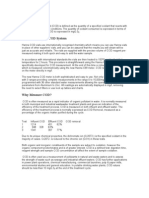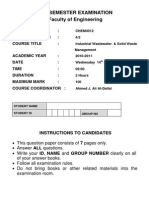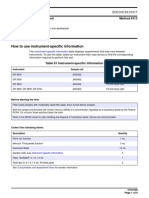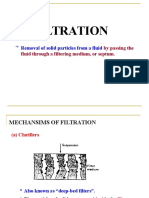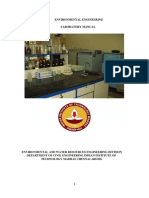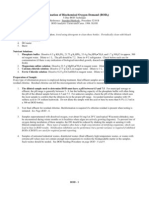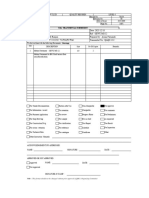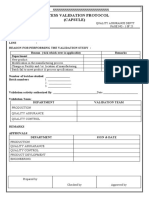BOD Procedure
BOD Procedure
Uploaded by
Sajith RanatungaCopyright:
Available Formats
BOD Procedure
BOD Procedure
Uploaded by
Sajith RanatungaOriginal Description:
Copyright
Available Formats
Share this document
Did you find this document useful?
Is this content inappropriate?
Copyright:
Available Formats
BOD Procedure
BOD Procedure
Uploaded by
Sajith RanatungaCopyright:
Available Formats
Determination of Biochemical Oxygen Demand (BOD 5)
5-Day BOD Technique Reference: Standard Methods,, Procedure 5210 B BOD Analysis: Curses and Cures. 1984. SLOH Apparatus: 1. 300 ml BOD bottles 2. 2 - 5 liter glass bottle with siphon . Avoid using detergents to clean these bottles. Periodically clean with bleach water. 3. 20 1C incubator 4. DO meter 5. Buret Nutrient Solutions: 1. Phosphate buffer: Dissolve 8.5 g KH2P04, 21.75 g K2HP04, 33.4 g Na2HP047H20, and 1.7 g NH4Cl in approx. 500 ml reagent water. Dilute to 1 L. The pH should be 7.2. Store in 4 C refrigerator. Check before each use for contamination (if there is any indication of biological/microbial growth, discard remaining reagent and prepare fresh). 2. Magnesium sulfate solution: Dissolve 22.5 g MgSO47H20 in reagent water. Dilute to 1 L. 3. Calcium chloride solution: Dissolve 27.5 g CaCl 2 in reagent water. Dilute to 1 L. 4. Ferric Chloride solution: Dissolve 0.25 g FeCl36H20 in reagent water. Dilute to 1 L. Preparation of Sample: If any type of chlorination process is employed during treatment, final effluent samples are initially tested for the presence of residual chlorine. Residual chlorine can kill the microorganisms which are critical to measuring BOD. 000000001. The diluted sample used to determine BOD must have a pH between 6.5 and 7.5 . For municipal sewage or effluent, the pH range is generally between 5 - 9, but the buffering capacity of the phosphate buffer will often bring the pH of the diluted sample between 6.5 and 7.5. For unknown samples, check the pH of the dilution which uses the most sample to confirm that the dilutions lie in the proper pH range. As needed neutralize samples with 1N sulfuric acid or 1N sodium hydroxide. Do not dilute the sample with the acid or base by more than 0.5% (1.5 ml in a 300 ml BOD bottle). 2. 3. Test final effluent for residual chlorine. Dechlorination is required if a chlorine residual is present when testing is initiated. See Page BOD - 6. Samples supersaturated with dissolved oxygen, over about 8.6 mg/l at 20 C (and typical Wisconsin altitudes), may be encountered during winter months or in localities where algae are actively growing (lagoons). To prevent loss of oxygen during incubation of these samples, the DO should be reduced by shaking the sample or aerating it with filtered compressed air. These types of samples often have a high concentration of nitrifying organisms, which can lead to bias in BOD results. Nitrification inhibition can be performed, but a permit variance is required if inhibited BODs (CBOD5) are used for required permit reporting . Samples of untreated industrial wastes, disinfected wastes (final effluent), high temperature wastes, or wastes with extreme pH values may not contain enough microorganisms to oxidize the biodegradable matter in the samples. Such wastes should be seeded. See BOD Seeding Procedure on page BOD - 8 and 9.
4.
Dilution Technique: 1. Estimate the B.O.D. of the sample and select suitable dilutions from the following tables: Estimated BOD5 (mg/L) < 5 < 10 10 - 30 30 - 60 60 - 90 Suggested Sample Volumes (mL) 200, 250, 300 100, 150, 200 25, 50, 100 15, 25, 50 10, 15, 25 Estimated BOD5 (mg/L) 90 - 150 150 - 300 300 - 700 700 - 1500 1500 - 2500 Suggested Sample Volumes (mL) 5, 10, 15 3, 5, 10 1, 3, 5 *** 0.5, 1, 3 *** 0.25, 0.5, 1 ***
BOD - 1
Standard Methods provides additional guidance as follows: use less than 3 mL for strong industrial wastes, 3-15 mL for raw and settled wastewater, and 15-75 mL for biologically treated effluent. When preparing replicate samples for quality control purposes, prepare the replicate at exactly the same dilutions as the original sample. See Helpful Hints #23 (September, 1992) for information regarding the preparation and calculation of BOD replicates. 2. Using a large-tipped, volumetric pipette - for samples less than 50 ml - or a graduated cylinder for larger sample volumes, measure the proper amount of well-mixed sample into thoroughly cleaned and rinsed 300 ml bottles. **** Dilutions under 3 mL must be made by diluting the waste in a graduated cylinder before pipetting . *** Dilution water may be prepared immediately before use, or, except for the addition of the phosphate buffer , days or weeks ahead of time. Add 1 ml or each nutrient solution per liter of dilution water. The phosphate buffer is the critical nutrient in stimulating contaminating growths so it must be added the day the water is to be used. Distilled water should be allowed to equilibrate in the incubator or with outside air for at least 24 hours at 20 C before use. To avoid dust or dirt contamination while allowing oxygenation, use a paper towel, cotton plug, or sponge to cover the bottle opening. Care is taken to ensure that dilution water is oxygen saturated. The use of aerator stones for this purpose should be discouraged as there is a tendency to develop growths which can prevent dilution water BOD criteria from being met. The best technique is to use compressed air which is passed through glass wool or a filter of some type to prevent the introduction of contaminants . 4. Each BOD bottle is filled by slowly adding sufficient dilution water so that the stopper can be inserted without leaving an air bubble but not so much that there is overflow. The siphon hose must be made of surgical gum (latex rubber), polypropylene or polyethylene to avoid introducing BOD into the dilution water. Tygon and black rubber can add oxygen demand to the water. When volumes of sample used exceed 150 ml, additional nutrients should be added to the sample bottle . Add an additional 0.1 mL of nutrients for each 50 mL of sample used in excess of 150 mL. For example, if the sample size is 200 ml, an additional 0.2 ml is required. 5. Completely fill two bottles with dilution water to be incubated as blanks. 6. Label each bottle carefully as to sample and volume used. RECORD ON BENCH SHEET.
3.
Incubation and Dissolved Oxygen (DO) Determinations: 1. Calibrate DO meter each day of use and check membrane on probe. Record the barometric pressure each day of analysis. This can be obtained from a barometer in the laboratory. Alternatively, barometric pressure readings can be obtained via the Internet, from a local radio or television news station, or from a local airport. Barometric pressure readings should not be corrected to sea level. NOTE: as a reference, typical barometric pressures range from about 29.6 to 30.3 inches (751.8 mm to 769.6 mm; 1002.36 to 1026.072 millibars) of mercury. Only under severe low pressure systems (seasonal storm systems, e.g., hurricanes or tornadic storms), does barometric pressure drop below 29.0 inches. 2. 3. Determine the DO of the two dilution water blanks and all sample bottles and record on data sheet as Initial DO. Place the samples and the 2 dilution water blanks in a 20 1C incubator for 5 days. Fill water seals with dilution water and cap to reduce evaporation from seals. Check daily, add water to seals if necessary. Due to the 5 day testing period, certain samples require that set-ups and run-outs of results be performed by different individuals . Before removing the caps, pour off the water above the cap. BOD - 2
4.
5.
After 5 days determine the DO of the two dilution water blanks and the sample bottles.
Calculations: In general, BOD5 values less than 2.0 mg DO/L should be reported on DMRs as non-detects ( i.e., < LOD). Using the data recorded for un-seeded samples: BOD mg/l = (Initial DO - DO5) x Dilution Factor Dilution Factor = Bottle Volume (300 ml) Sample Volume
Notes: 1. Blank BOD5. If the DO depletion in the dilution water blanks exceeds 0.2 mg/l, the results of the test are questionable. The results of samples which used the same dilution water the "high" blank should be qualified on the DMR. Do not subtract blank values from sample results. Dissolved oxygen values of the samples. Only dilutions with DO depletions of at least 2 mg/L, and DO5 of at least 1 mg/L may be used to calculate the sample's BOD. Average results from sample dilutions to calculate final sample BOD5. See page BOD - 9 for calculations appropriate for seeded samples
2. 3. 4.
If there is no evidence of toxic effects, average the results from all dilutions which meet the minimum oxygen depletion and minimum residual DO requirements. A toxic effect is indicated when BOD increases significantly as the sample dilution increases. This is often referred to as sliding BODs. Helpful Hints #17 (March, 1991) provides additional guidance for reporting results.
BOD - 3
Standardization of DO meter - Winkler Titration Technique
Reference: Standard Methods, 18 th edition, Procedure 4500-O C Reagents: 1. 2. 3. 4. 5. Manganous sulfate solution: Dissolve 480 g MnS0 4H20 in reagent water. Filter; dilute to 1 L. Alkali-iodide-azide reagent : Dissolve 500 g NaOH and 135 g NaI in reagent water. Dilute to 1 L. Add 10 g NaN3 dissolved in 40 ml reagent water. This reagent should not give a color with starch solution when diluted and acidified. Concentrated Sulfuric acid Standard sodium thiosulfate titrant, 0.0250N: Purchase commercially. Starch Solution: Prepare an emulsion of 5 g soluble starch in a mortar or beaker with a small amount of distilled water. Pour this emulsion into 1 L of boiling water, allow to boil a few minutes, and let settle overnight. Use the clear supernate. This solution may be preserved by the addition of 1.25 g salicylic acid/L and storage at 4 C.
Procedure: 1. Slowly siphon three portions of aerated dilution water into three separate BOD bottles. Avoid adding atmospheric O2 to dilution water. 2. 3. 4. To two of the three BOD bottles, add 1 ml MnS0 4 solution, followed by 1 ml alkali-iodide-azide reagent. Submerge pipette tips in sample when adding reagents. Rinse tips well between uses. Stopper carefully to exclude air bubbles; mix by inverting bottle several times. When precipitate has settled to about half the bottle volume, carefully remove the stopper and add 1.0 ml conc. sulfuric acid. Re-stopper and mix by gentle inversion until the iodine is uniformly distributed throughout the bottle. Transfer 203 ml of sample into a white 500 ml casserole dish and titrate with 0.0250N sodium thiosulfate to a pale straw color. Add 1-2 ml of starch solution and continue to titrate to first disappearance of the blue color. (200 ml of original dilution water is equal to 203 ml of dilution water plus reagents.)
5.
6. Titrate two of the three samples. Results should be within 0.1 mL if using a buret with increments of 0.05 mL. Calibrate the DO probe with the third bottle.
BOD - 4
Standardization of DO meter - Air calibrations Temperature ( C) 15 16 17 18 19 20 ambient 21 22 23 24 25
Calibration The Winkler titration is the most accurate method for standardizing a DO meter. If another method is used, it is suggested that the calibration be checked against a Winkler titration occasionally. If a meter is air calibrated, the reading must be corrected for atmospheric pressure. This is best done with a barometer kept in the lab, but another source of this information is a local airport or news station.. Atmospheric pressure readings obtained from an airport are generally corrected for sea level, and must be re-corrected for actual altitude. If you use a DO meter and probe, it is perhaps easiest if you calibrate according to the manufacturers instructions. There are two types of oxygen probes available: one of which employs a calibration based on water saturated air, and another based on air-saturated water. The water saturated air procedure involves storing the electrode in a sealed BOD bottle containing a minimal amount of water. For the air-saturated water calibration procedure, you either vigorously shake the solution or bubble air through it. There are, however, some concepts you should be familiar with to obtain the best quality results. 1. The best way to ensure data quality is to calibrate against a known standard. One way to do this is to use a sample of dilution water which has been saturated with oxygen. By knowing the temperature of the dilution water, and that it is a saturated solution, you then know what your meter should read for calibration. The table above is an abbreviated list of oxygen saturation levels versus temperature. Assuming your dilution water is at 20 C, if you obtain a measured value substantially less than 9.0 mg/L, you will not have an accurate calibration. 2. Some meters also allow the zero calibration standard. By adding an oxygen scavenger (e.g., an excess amount of sodium sulfite) to a sample of dilution water, you can obtain a sample which virtually contains zero oxygen.
Theoretical Maximum Oxygen Solubility (mg/L) 10.084 9.870 9.665 9.467 9.276 9.092 8.915 8.743 8.578 8.418 8.263
BOD - 5
Pretreatment of Chlorinated BOD Samples Reagents:
1. 2. 3. Acetic acid solution, 1+1: Add 500 ml. of concentrated acetic acid to 500 ml of distilled water. Potassium Iodide Solution: Dissolve 10 grams KI in a 100 ml volumetric flask. Bring to volume with distilled water. Sodium Sulfite Solution, 0.0250N: Dissolve 1.575 grams anhydrous NA2SO3 in a 1,000 ml volumetric flask. Bring to volume with distilled water.
NOTE: This solution is not stable and must be prepared daily.
4.
Starch Indicator Solution (For Analysis with Iodine) : Prepare an emulsion of 5 g soluble starch in a mortar or beaker with a small amount of distilled water. Pour this emulsion into 1 L of boiling water, allow to boil a few minutes, and let settle overnight. Use the clear supernate. This solution may be preserved by the addition of 1.25 g salicylic acid/L and storage at 4C.
Procedure: 1. Conduct a chlorine residual analysis on a portion of the sample collected . Potassium iodide/starch paper can be used as a quick qualitative test for residual chlorine . If no residual is found, proceed with the BOD analysis utilizing seeded dilution water. If a residual is found, proceed with the following steps before initiating the BOD test. Determination of Appropriate Volume of Sodium Sulfite a. b. c. d. e. f. 3. Obtain a 200 ml portion of the sample to be tested. Add 10 ml of 1+1 acetic acid solution Add 10 ml of potassium iodine solution Add 2 ml starch Titrate with 0.0250N sodium sulfite. The end point has been reached when a clear color persists after complete mixing. Measure volume of 0.0250N sodium sulfite used.
2.
Sample Pretreatment a. b. c. d. Obtain another 200 ml portion of the same sample used in Step 2. Add to the sample the same volume of 0.0250N sodium sulfite solution that was determined in Step 2.e and mix. Retest for residual chlorine after allowing the sample to stand for 10-20 minutes. If no residual chlorine is present, proceed with the BOD analysis. Samples which have been chlorinated must be seeded.
BOD - 6
Preparation of Glucose - Glutamic Acid Standard (GGA)
Reagents: Note: glucose/glutamic acid solution can be purchased commercially, but needs to be preapred usch that the GGA concentrations are equal to 150 mg/L each. 1. 2. Reagent grade glucose Reagent grade glutamic acid
Procedure: 1. 2. Dry reagent grade glucose and glutamic acid at 103 C for 1 hour and cool for one hour in the desiccator. Dissolve 150 mg (0.150 g) of glucose and 150 mg (0.150 g) of glutamic acid in distilled water and bring up to 1 L.
Note:This solution will become contaminated quickly and must be used immediately unless the following is done. Place into each of several milk dilution bottles or capped test tubes the quantity of the GGA standard which is used in one day. Seal the bottles and sterilize them. These sterilized portions can then be cooled and stored at 4 C. When a known standard is run, 6 ml of GGA standard from one of the sealed/sterilized containers is added to each BOD5 bottle and the bottles are filled 3/4 full with dilution water. (This is critical! 198 30.5 mg Oxygen/L is based on a 2 % dilution of GGA (6 mL/300). It is important not to use multiple dilutions which use other than 6 mL). Seed is then added and the bottle is filled with dilution water. These bottles are incubated and BOD is determined similar to sample bottles.
3.
The acceptable BOD5 value of the standard is 198 30.5 mg/l. If the calculated result falls outside this range the cause of the problem must be identified. Sample results obtained using the same seed or dilution water as the standard must be qualified. Once the problem is corrected another known should be set up immediately.
BOD - 7
BOD Seeding Procedure
Preparation of Seed: 1. Collect a raw influent grab sample the day before performing the test. If the influent contains significant industrial loading, settled mixed liquor may provide a better seed than raw influent. If used for seed, settled mixed liquor does not need to be incubated at 20 C overnight. Seed can also be commercially obtained. There are at least two products widely in use: BioSeed , and PolySeed . 2. Place sample in incubator (20C) overnight.
Preparation of Seed Controls: Table 8 gives general directions for determining the amount of seed to add to seed controls and samples. 1. Take the incubated raw influent sample out of the incubator -- DO NOT MIX. 2. 3. 4. Pipet 3, 5, and 7 ml of the clear supernatant into three BOD bottles respectively. Use other volumes of supernatant based on the strength of your system. You MUST use at least two different dilutions. Fill these three bottles with BOD dilution water. Determine the initial dissolved oxygen on each of the three bottles.
Preparation of Seeded BOD Samples: 1. Fill the bottles approximately 1/3 - 1/2 with dilution water. 2. 3. 4. 5. Pipet 2 ml of the supernatant into each of the BOD sample bottles that will require seeding. Add the appropriate amount of sample to each of the bottles. Complete the filling of the BOD bottles with dilution water. Determine the initial dissolved oxygen (IDO) on each of the bottles.
Calculation of Seed Correction: 1. Determine the 5 day DO concentration on each of the seed controls. 2. 3. 4. Use the same rule for DO depletion as in all other BODs (at least 2.0 mg/L DO depletion and at least 1.0 mg/L residual DO (after 5 days) (Standard Methods, 18th edition)). If none of the bottles attain a proper depletion, adjust the amount of seed addition accordingly in subsequent tests. For each seed control dilution, the mg DO used per ml seed = (IDO - DO5 for seed control) ml seed in seed control If two seed controls meet the DO depletion criteria, calculate the average mg DO depleted/mL seed. Seed correction = (mg DO/ ml seed in seed control) x (ml seed added to samples @)
@ If the seed is diluted before it is added to the sample bottles, the ml of the diluted seed added to the sample bottle must be multiplied by a dilution factor. (Ex. If 10 ml seed + 90 ml water are mixed to produce the seeding material, the dilution factor is 1/10.)
5. 6.
7.
If the seed correction does not fall in the range of 0.6-1.0, but the seed controls met the DO depletion criteria, the amount of seed used in the sample bottles will have to be adjusted in subsequent tests.
Calculation of BOD in sample : BOD5 = BOD mg/l = [(IDO -DO5) - seed correction] x dilution factor * dilution factor = 300 BOD - 8
sample size (mL) Table 8 - BOD SEED DILUTION GUIDELINES (1) Estimated BOD of seed 30 50 100 150 250 500 (2) Dilutions for Seed Control 15, 25, 50 15, 25, 50 5, 10, 15 5, 10, 15 3, 5, 10 1, 3, 5 (3) # mL seed per BOD bottle 6 - 10 4-6 2-3 1-2 1 0.5 (4) # mL diluted seed (10 mL seed + 90 mL water) NA NA NA NA 6 - 10 5
If the BOD of the seed is 150 mg/L or less, the seed may be added directly to the BOD samples without dilution. If dilution is necessary, use volumes noted in column (4). Set up the seed control dilutions as shown in column (2). Prepare seed controls with seed at full strength. Seed Correction Sample Calculation:
SEED CONTROL BOTTLE
IDO
DO5
DEPLETION
# mL SEED IN BOTTLE 30 20 10
mg DO/mL SEED -.-0.34 0.41
A B C
NOTE:
8.5 8.4 8.4
0.3 1.6 4.3
8.2 6.8 4.1
Bottle A is not used due to the insufficient final DO. There must be a residual DO of at least 1.0 mg/L after 5 days.
(0.34 + 0.41)/2 = 0.375 mg DO/ml seed
If 2 ml undiluted seed added to each sample bottle, seed correction = (0.375 mg DO/ml seed)(2 ml seed) = 0.75 mg DO
BOD - 9
Facility Name: _____________
BOD5 Benchsheet
Sample Location (specific) Sample Type (grab, xx hr Comp., etc.) Raw ___________ ________________________________ Final ___________ ________________________________ ________ ___________ ________________________________ ________ ___________ ________________________________ ________ ___________ ________________________________ Sample Date: ________________ Collected by: ________________ Samples IN Date: __________ Time: _________ Room Temp (C) __________ Barometric pressure __________ Test Date: Analyst: Samples OUT Room Temp (C) Barometric pressure Initial DO (mg/L) Final DO (mg/L) ________________ ________________ Date: __________ Time:__________ _______________ _______________ Depletion (mg/L) Comments
Depletion must be less than 0.2 mg/L
Bottle # Blank Seeded Blank Seed source: _______________ Sample mLs A Raw Final GGA
Replicate of______
Sample mLs
Seed Correction factor (SCF):
Seed mLs
____________ Dilution factor
F=300/A
Sample
Bottle #
added
Initial DO B
Final DO C
DO
depletion
SCF E
BOD5 mg/L
F x (D-E)
Average
BOD5
D=B-C
Average only those values which are associated with a depletion of at least 2 mg/L and a final DO 1 mg/L. BOD5 mg/L = [ (B-C)-E] x F
Calculation =
Lab Equipment Maintenance and Calibration Log
Month ____________ Year ________
Date
Analyst Intials
Sampler
Temp. (C)
Refrig. Temp. (C)
TSS Oven Temp C
BOD
Incubator
Fecal
Incubator
Temp C
Temp C
pH Meter buffers
BOD
Barometer
reading
BOD Room
Temp C
1 2 3 4 5 6 7 8 9 10 11 12 13 14 15 16 17 18 19 20 21 22 23 24 25 26 27 28 29 30 31 Monthly Balance Check Monthly Balance Check Membrane changes: DO probe _______________ _______________ _______________
weight in milligram range: Actual weight(mg):__________ Measured weight(mg) __________ weight in gram range: Actual weight (g):__________ Measured weight (g) __________
Ammonia probe ______________ ______________ ______________
Other probe _______________ _______________ _______________
TSS Oven should be 103-105 C BOD Incubator should be 20 1 C Sampler and Refrigerator Temperature should not exceed 4 C (and samples should not be frozen) pH calibration should be done with either a 4 and 7 buffer or a 7 and 10 buffer, depending on sample pH range. Once calibrated, one of the two buffers should be re-checked as if it was a sample. The measured pH should be within 0.1 pH unit of actual pH.
Corrective Action Form
QC failures
What QC type failure is involved: ___blank ___known standard ___calibration ___matrix spike ___replicate ___blind ___other Blank: what is the LOD? _____ What level was detected in the blank? _______ Spikes/replicates: What are the acceptance criteria? ______ Your result? _______ If a matrix spike: Is this a matrix interference? ____ How do you know that? ____________ _____________________________________________________________________________ Known standards/blinds: True Value: _____ Acceptance criteria? ______ Your result? ______ Other pertinent information____________________________________________________________ ___________________________________________________________________________________ _
Other problems
(equipment malfunctions, etc.) Symptom(s) (how did you know something was wrong ?):_________________________________________ ___________________________________________________________________________________ _ ___________________________________________________________________________________ _ ___________________________________________________________________________________ _ ___________________________________________________________________________________ _ ___________________________________________________________________________________ _
Corrective Action Taken
List any activities or checks you performed to identify the source and resolve the problem.
Action/Check Performed Date___ _______________________________ _______________________________ _______________________________ _______________________________ _______________________________
What did you conclude? ______________________________ ______________________________ ______________________________ ______________________________ ______________________________
Initials ______ ______ ______ ______ ______ _______ _______ _______ _______ _______
Resolution Date: _________
Briefly document how you know this problem has been corrected. What changes have you made to prevent it from recurring?
___________________________________________________________________________________ _ ___________________________________________________________________________________ _ ___________________________________________________________________________________ _ ___________________________________________________________________________________ _ ___________________________________________________________________________________ _ ___________________________________________________________________________________ _
You might also like
- BOD Lab ReportDocument11 pagesBOD Lab ReportShauQi Lutfi100% (3)
- Asme b31.8 Comp Iso 13623Document7 pagesAsme b31.8 Comp Iso 13623tss13723100% (2)
- Final Experiment 3Document6 pagesFinal Experiment 3Joevani DomingoNo ratings yet
- Objectives: Chapter 4 Sludge Treatment and DisposalDocument37 pagesObjectives: Chapter 4 Sludge Treatment and Disposalashe zinabNo ratings yet
- Kjeldahl Nitrogen AnalysisDocument7 pagesKjeldahl Nitrogen AnalysisCristina AreolaNo ratings yet
- Determination of Iodine Value of Activated CarbonDocument2 pagesDetermination of Iodine Value of Activated CarbonSaleem BashaNo ratings yet
- Shortcut Nitrogen Removal-Nitrite Shunt and DeammonificationFrom EverandShortcut Nitrogen Removal-Nitrite Shunt and DeammonificationNo ratings yet
- Determination of Biochemical Oxygen Demand (BOD) : WaterDocument14 pagesDetermination of Biochemical Oxygen Demand (BOD) : WaterHimu DasNo ratings yet
- Bod AimDocument3 pagesBod Aimrockingtwo07No ratings yet
- BOD DilutionMethod LitNo8043Document11 pagesBOD DilutionMethod LitNo8043Michael PintoNo ratings yet
- SepaDocument4 pagesSepaRobert DelfinNo ratings yet
- BOD and CODDocument7 pagesBOD and CODShannen SiyNo ratings yet
- Unit 1. Itroduction To Wastewater TreatmentDocument28 pagesUnit 1. Itroduction To Wastewater Treatmentsssshekhar100% (1)
- Biochemical Oxygen Demand or Biological Oxygen DemandDocument3 pagesBiochemical Oxygen Demand or Biological Oxygen DemandEllieNo ratings yet
- Soln Sa Adsorption PDFDocument2 pagesSoln Sa Adsorption PDFRee ValeraNo ratings yet
- CCN2252 Environmental and Energy Engineering T08 Water PollutionDocument3 pagesCCN2252 Environmental and Energy Engineering T08 Water PollutionfelixNo ratings yet
- 3025 44Document6 pages3025 44rambinod100% (1)
- Momentum Transport Operations External Flow Past Immersed BodiesDocument1 pageMomentum Transport Operations External Flow Past Immersed BodiesGerald LimNo ratings yet
- Cod BodDocument4 pagesCod Bodgurubakkiamjai100% (1)
- Lab Manual-Total AlkalinityDocument4 pagesLab Manual-Total AlkalinitySuvanka DuttaNo ratings yet
- Midterm - Exam CHEM4012 2010 2011Document7 pagesMidterm - Exam CHEM4012 2010 2011Zezo AlNo ratings yet
- CHEM 1235 Volumetric QuizDocument1 pageCHEM 1235 Volumetric QuizJesseca Calaunan QuintoNo ratings yet
- GATE Chemical Engineering 2002Document10 pagesGATE Chemical Engineering 2002rahulsaini855No ratings yet
- Determination of Biochemical Oxygen DemandDocument12 pagesDetermination of Biochemical Oxygen DemandIbrahim DewaliNo ratings yet
- Assignment 1Document3 pagesAssignment 1Victor Megong JakiNo ratings yet
- Simultaneous Spectrophotometric Determination of Manganese and ChromiumDocument10 pagesSimultaneous Spectrophotometric Determination of Manganese and ChromiumOmarion Pusey100% (1)
- Bod TestDocument11 pagesBod TestEilya Al-mafrajjeNo ratings yet
- 21810, Ultrapure Water Breakpoint CL andDocument5 pages21810, Ultrapure Water Breakpoint CL andWaleed EmaraNo ratings yet
- Experiment 6 - EDTA Titration of The Hardness of WaterDocument2 pagesExperiment 6 - EDTA Titration of The Hardness of Waterfrogie90100% (1)
- Experiment 2 3 4 Total Solid Ts Total SuDocument9 pagesExperiment 2 3 4 Total Solid Ts Total SuBiswa Jyoti GuptaNo ratings yet
- Unit 1 Calculations and Chemical ReactionsDocument7 pagesUnit 1 Calculations and Chemical ReactionsVeraNo ratings yet
- Anaerobic DigestionDocument23 pagesAnaerobic DigestionguruprasadmhugarNo ratings yet
- Determination of Hardness of Water (Step-By-Step Plan)Document6 pagesDetermination of Hardness of Water (Step-By-Step Plan)ravenheart90No ratings yet
- AlkalinityDocument3 pagesAlkalinityGajaNand Mallick100% (1)
- HACH Chloride by Thiocyanate-Method No.8113-DOC316.53.01017 - Ed7Document6 pagesHACH Chloride by Thiocyanate-Method No.8113-DOC316.53.01017 - Ed7Balas43No ratings yet
- Basic Lab Operations PDFDocument5 pagesBasic Lab Operations PDFErzhan OmarbekovNo ratings yet
- B7 PROJECT REPORT NewDocument21 pagesB7 PROJECT REPORT NewvijayNo ratings yet
- Tutorial 1 WastewaterDocument2 pagesTutorial 1 WastewaterAnonymous Vx9KTkM8nNo ratings yet
- Mini Project ReportDocument5 pagesMini Project ReportSaj BhaiNo ratings yet
- She BoardDocument58 pagesShe BoardtreekyNo ratings yet
- Depre ContDocument31 pagesDepre ContBalu BalireddiNo ratings yet
- 05-Chem Eng Tools 2016Document11 pages05-Chem Eng Tools 2016Hazel Raditya MizumareruNo ratings yet
- Exercise 6 Problem Set On Water and Wastewater CHE185-1Document3 pagesExercise 6 Problem Set On Water and Wastewater CHE185-1Chelsea Martinez0% (1)
- ch4 Water Quality Engineering PDFDocument26 pagesch4 Water Quality Engineering PDFashe zinabNo ratings yet
- Jar Test Dcc40172 Alif, Anis, ZulianaDocument10 pagesJar Test Dcc40172 Alif, Anis, ZulianaAnis NurdiniNo ratings yet
- Final Project ReportDocument16 pagesFinal Project Reportdavid_tomy_1No ratings yet
- Experiment No. 5 Date: Title:: Determination of Sludge Volume Index in A Given Wastewater SampleDocument7 pagesExperiment No. 5 Date: Title:: Determination of Sludge Volume Index in A Given Wastewater SampleMac357GNo ratings yet
- Btech I Sem Engineering Chemistry Lab: Viva Voce Questions For Mid Sem Practical ExamDocument2 pagesBtech I Sem Engineering Chemistry Lab: Viva Voce Questions For Mid Sem Practical ExamAashish KushwahaNo ratings yet
- ArihantDocument14 pagesArihantunknwn2009No ratings yet
- General-Chemistry Calculations January 2018Document2 pagesGeneral-Chemistry Calculations January 2018Raymond Yabut100% (2)
- BS 2 FiltrationDocument70 pagesBS 2 FiltrationRavi Kumar VermaNo ratings yet
- LECTURE 30 Application of AAS For Industrial SamplesDocument34 pagesLECTURE 30 Application of AAS For Industrial SamplesAMNA BASHARAT BS ChemistryNo ratings yet
- Baume Scale: Pure Water 15 (W/W) % Nacl Calibration of A Heavierthan-Water Hydrometer Onthe Baumé ScaleDocument3 pagesBaume Scale: Pure Water 15 (W/W) % Nacl Calibration of A Heavierthan-Water Hydrometer Onthe Baumé ScaleAltaf Ur RehmanNo ratings yet
- Removal of Permanent Hardness of WaterDocument7 pagesRemoval of Permanent Hardness of WaterMurugappan Elango100% (1)
- PROBLEMS - Module 4 - Water Pollution Control by Biological MethodsDocument4 pagesPROBLEMS - Module 4 - Water Pollution Control by Biological MethodsAke TupeslaNo ratings yet
- Environmental Engineering LabmanualDocument32 pagesEnvironmental Engineering LabmanualrupenderNo ratings yet
- The Solid Phase Micro Extraction (SPME) of Water and Its Headspace For The Analysis of Volatile and Semi-Volatile Organic CompoundsDocument6 pagesThe Solid Phase Micro Extraction (SPME) of Water and Its Headspace For The Analysis of Volatile and Semi-Volatile Organic CompoundsEugene GudimaNo ratings yet
- Treatment of Softdrink Industry Wastewater Using An Integrated Anaerobicaerobic Membrane BioreactorDocument154 pagesTreatment of Softdrink Industry Wastewater Using An Integrated Anaerobicaerobic Membrane BioreactorAbiodun Gbenga100% (1)
- Past Board Answer KeyDocument23 pagesPast Board Answer KeyBryle CamaroteNo ratings yet
- Environmental Eng'gDocument2 pagesEnvironmental Eng'gVaan100% (1)
- Share BOD ProcedureDocument13 pagesShare BOD ProcedureZlatko SimjanoskiNo ratings yet
- Head & Side Wall SectionsDocument1 pageHead & Side Wall SectionsSajith RanatungaNo ratings yet
- Application For Post of DOCUMENT ASSISTANT - Noth Western Province Canal (NWPCP)Document1 pageApplication For Post of DOCUMENT ASSISTANT - Noth Western Province Canal (NWPCP)Sajith RanatungaNo ratings yet
- Structural Engineering 2Document6 pagesStructural Engineering 2Sajith RanatungaNo ratings yet
- Geo Technical EngineeringDocument7 pagesGeo Technical EngineeringSajith RanatungaNo ratings yet
- Regulator GateDocument1 pageRegulator GateSajith RanatungaNo ratings yet
- Survey CampDocument27 pagesSurvey CampSajith RanatungaNo ratings yet
- Industrial Training at Deyata Kirula 2013Document18 pagesIndustrial Training at Deyata Kirula 2013Sajith RanatungaNo ratings yet
- 214 CHPT 11Document18 pages214 CHPT 11Daniel RandolphNo ratings yet
- Frame Analysis Ver W2Document14 pagesFrame Analysis Ver W2Sajith RanatungaNo ratings yet
- Doc1 - Copy - 2Document6 pagesDoc1 - Copy - 2Sajith RanatungaNo ratings yet
- WCC 103 Manual 2003 Soil Sand Silt ClayDocument6 pagesWCC 103 Manual 2003 Soil Sand Silt ClayEeusha NafiNo ratings yet
- C ImportantDocument3 pagesC ImportantSajith RanatungaNo ratings yet
- Calendar NewDocument2 pagesCalendar NewSajith RanatungaNo ratings yet
- Sigmacover 280 (Primer) For HDG SurfaceDocument6 pagesSigmacover 280 (Primer) For HDG SurfaceRauf AliyevNo ratings yet
- Rubber Pad FormingDocument11 pagesRubber Pad FormingvelavansuNo ratings yet
- Self-Assessments 7 PDFDocument6 pagesSelf-Assessments 7 PDFUmme Abdullah0% (1)
- CPM HPLCDocument4 pagesCPM HPLCmay16forhenry4906No ratings yet
- National Drug Policy FinalDocument10 pagesNational Drug Policy Finalezechisom135No ratings yet
- Lpo ApotekDocument132 pagesLpo Apotekdessy wilantariNo ratings yet
- DLL g5 q1 Week 3 All Subjects (Mam Inkay Peralta)Document62 pagesDLL g5 q1 Week 3 All Subjects (Mam Inkay Peralta)Lorie Ann GonzalesNo ratings yet
- 17 Bản - Past Papers CheckpointDocument100 pages17 Bản - Past Papers Checkpointhoanganh.hana01No ratings yet
- Spectroscopic Properties of Inorganic and Org A No Metallic Compounds - Vol1Document406 pagesSpectroscopic Properties of Inorganic and Org A No Metallic Compounds - Vol1chemanalyserNo ratings yet
- Aquasoft CI - MSDSDocument3 pagesAquasoft CI - MSDSJaleel Ahmed100% (1)
- Cas No. 5877-42-9Document11 pagesCas No. 5877-42-9jangri1098No ratings yet
- Palm Oil Standard MethodDocument3 pagesPalm Oil Standard MethodUswatul HasanahNo ratings yet
- ForoDocument12 pagesForoliber mutusNo ratings yet
- Unit 4-Photosynthesis QuestionsDocument41 pagesUnit 4-Photosynthesis Questionsareyouthere92100% (3)
- Chapter 11 Corrosion and Degradation of MaterialsDocument35 pagesChapter 11 Corrosion and Degradation of MaterialsSKULLZER GAMINGNo ratings yet
- Project Report On Toilet and Herbal SoapDocument9 pagesProject Report On Toilet and Herbal SoapEIRI Board of Consultants and Publishers0% (1)
- MS-B01 Roof Terrace Floor Crack RectificationDocument27 pagesMS-B01 Roof Terrace Floor Crack RectificationaruanNo ratings yet
- Analysis of Sulphonated DyesDocument11 pagesAnalysis of Sulphonated DyesrajdewaanNo ratings yet
- Sanitary Installation Works: Chapter - S-1Document74 pagesSanitary Installation Works: Chapter - S-1Ravindu RansaraNo ratings yet
- Chapter 8Document89 pagesChapter 8Mustafa TataNo ratings yet
- XXXXXXXXXXXXXXXXXXXXXXXXXXXX Process Validation Protocol (Capsule)Document25 pagesXXXXXXXXXXXXXXXXXXXXXXXXXXXX Process Validation Protocol (Capsule)Navdeep ChaudharyNo ratings yet
- Copper Bonded Ground RodDocument7 pagesCopper Bonded Ground RodAmiableimpexNo ratings yet
- Common Insect Pests of StrawberriesDocument4 pagesCommon Insect Pests of StrawberriesHòa Bùi0% (1)
- Cambridge Secondary Two Science: Chapter 8: MixturesDocument28 pagesCambridge Secondary Two Science: Chapter 8: MixturesarenestarNo ratings yet
- Environment and Sustainable Development: Archana T Xii-E 27Document34 pagesEnvironment and Sustainable Development: Archana T Xii-E 27Archana TNo ratings yet
- Problems in Fluid Mechanics BaranyiDocument130 pagesProblems in Fluid Mechanics BaranyiNurhazimah IsmailNo ratings yet
- Load Cell Sensator E80 TW561Document8 pagesLoad Cell Sensator E80 TW561pwmvsi100% (9)
- Milling Catalog PDFDocument335 pagesMilling Catalog PDFTuấn NguyễnNo ratings yet
- Phy Sci Module 2Document30 pagesPhy Sci Module 2Remar Jhon PaineNo ratings yet


















